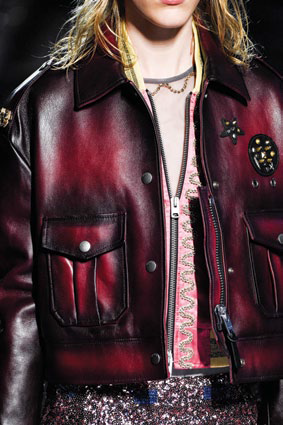Stuart Vevers’ spring/summer 2018 collection for Coach 1941 is a love letter dedicated to New York and the spirit of her people.



I first spoke to Stuart Vevers two summers ago in Coach’s old showroom located a few blocks away from New York’s Hudson Yards, a gleaming cluster of skyscrapers rising from midtown Manhattan. Fresh from Coach 1941’s debut runway show, a beaming and visibly relaxed Vevers was busy fielding questions from fashion journalists about the momentous catwalk production, which was presented atop the High Line with the company’s yet-to-be completed headquarters towering in the background. “It’s a reality: A beautiful leather coat with a t-shirt; the high-and-low mix that somehow feels youthful and contemporary… Fashion is more and more about the story each individual item tells,” Vevers explained back then of the selection of patchwork leather jackets and floral tea dresses that spelt out his plans for the brand. “I do what I can, what I believe in, and I’m staying true to that.”

Through it all, Vevers continues to drive Coach’s growth by remaining steadfast in his vision for the American leather goods brand. “When I started at Coach four years ago, I used its heritage and archives to give me a sense of what being at the brand meant and to give me a sense of direction so that I can look boldly forward,” the British-born designer said. And look forward he did.Vevers’ ongoing evolution of the brand is a reimagining of classic Americana— nostalgic, romantic but ultimately modern, playful and wearable.
For spring/summer 2018, Vevers decided to honour New York, a city inexplicably linked to Coach’s history. “I wanted to celebrate New York’s diversity and creativity,” Vevers explained post-show. “I think the city’s the coolest in the world, and I really wanted to celebrate the people who have inspired me over the years and continue to do so today.”

The main highlight of the show, however, was the appearance of Keith Haring’s graphic illustrations as a leitmotif in the collection. The late artist is one of Vevers’ heroes, and the designer found a strong connection between the “democratic” nature of Haring’s graffi ti art and Coach’s values of aff ordable luxury for all. “His art was about being inclusive. It had a warmth and playfulness to it, and I feel that is very close to what Coach stands for,” Vevers elaborated. He then applied Haring’s signature squiggles liberally on snug sweaters, shearling jackets and t-shirts, plus a host of other accessories that will surely appeal to fashion and art aficionados alike.





PHOTOGRAPHY: SHOWBIT; COURTESY OF COACH























